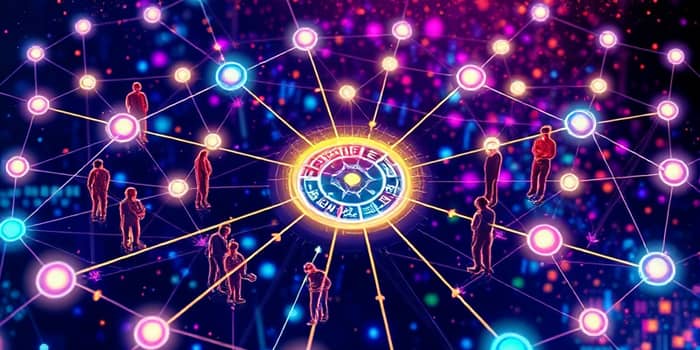Decentralized Autonomous Organizations (DAOs) have rapidly gained traction as a groundbreaking approach to collective governance and resource allocation. Rooted in blockchain technology and automated code, DAOs promise a departure from traditional hierarchical models, ushering in an era of community-driven decision-making.
Definition and Core Principles
DAOs are entities with no central leadership, governed entirely by transparent protocols and smart contracts. Members participate by holding governance tokens, each of which confers voting power proportional to its stake. This system fosters community-driven rules enforced on a blockchain, ensuring every action and transaction remains publicly auditable.
Key principles include:
- Decentralization: No single authority controls the organization.
- Transparency: All rules and transactions are visible on-chain.
- Automation: Decisions execute automatically via coded agreements.
- Inclusivity: Anyone meeting predefined criteria can join and contribute.
Technical Structure and Mechanism
Under the hood, DAOs rely on self-executing protocols known as smart contracts. These contracts encode critical functions such as voting, treasury management, and membership rules. When members cast votes, the smart contract tallies results and executes approved proposals without manual intervention.
Tokenized ownership forms the backbone of this architecture. Governance tokens represent voting rights, while multisignature wallets and treasury modules manage funds. Together, these components create a resilient framework for collective action, minimizing reliance on intermediaries.
Historical Context and Evolution
The concept of decentralized governance predates DAOs, but the first modern DAO emerged on Ethereum. In 2016, “The DAO” experiment highlighted immense potential—and risks—when a vulnerability led to a major hack. This event underscored the necessity of rigorous code audits and robust security practices.
Since then, DAO frameworks have matured significantly. Today’s ecosystems boast advanced governance modules, modular voting plugins, and layer-2 scaling solutions that address early scalability challenges.
Market Size and Growth Trends
As of 2025, DAOs have entered mainstream awareness, with over 13,000 active organizations worldwide. Total liquid assets under DAO control exceed $21.4 billion, reflecting a compounded annual growth rate of about 30%.
Regional adoption varies, with the Asia-Pacific region leading expansion. Conference attendance surged 40% in 2025, indicating deepening community engagement and global interest.
Key Use Cases
DAOs unlock novel applications across industries, transforming established processes:
- DeFi Governance: Platforms like Uniswap and MakerDAO rely on token-holder votes to steer protocol changes.
- NFT and Gaming Communities: Members guide creative roadmaps and manage shared treasuries.
- Venture Capital Clubs: Investors pool funds and democratically decide on startups.
- Philanthropy Initiatives: Environmental and social cause DAOs coordinate grants and donations transparently.
- Content Creation Networks: Creators and audiences co-govern platforms, sharing revenue and influence.
Benefits and Novel Advantages
DAOs offer decentralized governance without intermediaries, eliminating single points of failure. Transparency is baked in, with every transaction visible on-chain, fostering public auditability and trust among participants.
Automation reduces human error and operational costs, while token incentives drive engagement and reward valuable contributions. For global teams, DAOs facilitate borderless collaboration under a unified rule set.
Challenges and Risks
Despite their promise, DAOs face ongoing hurdles:
- Security Vulnerabilities: Smart contract bugs can lead to catastrophic fund losses.
- Scalability Constraints: On-chain voting may incur high fees and latency.
- Token Concentration: Large holders can exert disproportionate influence.
- Legal Ambiguity: Jurisdictions differ on recognizing code-based entities.
- Governance Gridlock: Diverse communities may struggle to reach consensus.
Future Directions and Trends
Looking ahead, DAO analytics tools are improving by over 35%, enhancing transparency and strategic insights. DAO-as-a-Service platforms simplify deployment, enabling organizations to launch governed entities in days rather than months.
Projections indicate that by 2027, 80% of DAOs will adopt fully automated governance stacks. Traditional businesses are also piloting DAO models to bolster trust and stakeholder alignment.
Major Platforms and Legal Perspectives
Leading infrastructure providers include Aragon and DAOstack, offering modular tooling for governance and treasury management. While Ethereum remains dominant, alternatives such as Solana and Polygon host growing DAO ecosystems.
On the regulatory front, states like Wyoming now recognize DAOs as legal entities with limited liability. Nonetheless, global consensus on DAO governance and accountability frameworks remains a work in progress.
Community and Cultural Impact
DAOs empower participants with a sense of ownership and purpose. By democratizing decision-making, they foster inclusive participation across borders and drive cultural shifts toward transparent collaboration.
Community events and virtual summits have become focal points for networking, learning, and innovation. As DAO culture matures, it challenges conventional corporate norms, inspiring new models of shared prosperity.
Conclusion
Decentralized Autonomous Organizations represent a transformative paradigm shift in governance. By combining blockchain transparency, automated execution, and community-driven decision-making, DAOs are redefining how groups collaborate and allocate resources.
While security, scalability, and legal clarity remain challenges, the momentum behind DAOs is undeniable. As tools and frameworks evolve, we can expect even broader adoption across sectors, ultimately reshaping organizational structures for the digital age.
References
- https://www.coinbase.com/learn/crypto-basics/what-are-decentralized-autonomous-organizations
- https://coinlaw.io/decentralized-autonomous-organizations-statistics/
- https://corporations.utah.gov/2023/12/15/decentralized-autonomous-organization-dao/
- https://www.intelmarketresearch.com/information-and-communication-technology-and-media/4979/decentralized-autonomous-organization-development-2025-2032-335
- https://www.bitlaw.com/blockchain/DAO.html
- https://market.us/report/dao-as-a-service-daoaas-market/
- https://www.chainalysis.com/blog/introduction-to-decentralized-autonomous-organizations-daos/
- https://www.futuredatastats.com/decentralized-autonomous-organizations-daos-market










